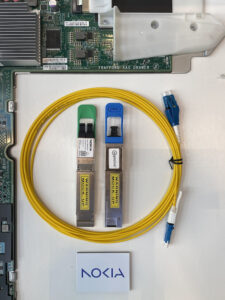Nokia and SURF have successfully tested an 800 Gbit/s data connection between Nikhef in Amsterdam and CERN in Geneva. Such a record speed is needed to transmit data from the upcoming high-luminosity LHC accelerator.

Nokia’s latest photonic technology, the sixth-generation super-coherent Photonic Service Engine (SPE-6s), was deployed in the tests, along with 16QUM-shaped modulation. The results of the tests will be announced in more detail next week at a Nokia expert conference in Athens.
Data hub
Nikhef and SURF form a so-called Tier-1 data node in the international GRID data network from CERN, located at the Nikhef data center in Amsterdam. The existing connections to CERN have a maximum capacity of 400 Gbit per second. For the future, five times more intense data streams from the accelerator in Geneva, even that is not enough.
At the high-luminosity LHC, the colliding beams of protons will be ten times more intense, allowing more subtle details of particle collisions to be viewed with much more measurement data. The HL-LHC is scheduled to come into operation in 2029 after an extensive refurbishment of the current LHC accelerator at CERN.
Huge potential
Nokia says it is pleased with the results of the test earlier this spring. The tests used real data from the ATLAS detector at CERN. “Nokia and SURF were able to show that the existing fiber infrastructure still has enormous potential and can handle the future capacity requirements of international scientific instruments.”
Nikhef IT architect Tristan Suerink was involved in the 800 Gbit capacity tests from the beginning. He calls the outcome gratifying. “This experiment shows that we really can get the data from the HL-LHC in Geneva to Amsterdam. The work with Nokia and SURF gives us a glimpse of the future and it looks good.”